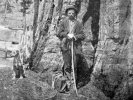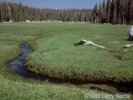 Carl Purpus, Plant Collector in
Western America
Carl Purpus, Plant Collector in
Western America 
Carl A. Purpus Translation by Barbara Ertter
 Carl Purpus, Plant Collector in
Western America Carl Purpus, Plant Collector in
Western America | Report on my collecting trip this year [1896] through the southeastern Sierra Nevada of California |

| Carl A. Purpus Translation by Barbara Ertter |
 




|
Original Title Bericht uber meine diesjahrige Sammeltour durch die sudostliche Sierra Nevada von Californien Von C. A. Purpus. Daunt Tulare Co. Calif. Mitt. Deutsch. Dendrol. Ges. 5: 229-235.
| Locations: Springville.
I departed with a companion [or guide] and several pack animals from my base camp [near Springville] in the chaparral region on the west side of the Sierra Nevada in June, on a journey to collect in the southeastern Sierra. The chaparral, as it is called, is interrupted by open grasslands sparsely wooded with Quercus douglasii Hook. & Arn. Above 3000 feet this species is joined by Q.
chrysolepis Liebm. and Q. kelloggii Newb., which ascend to the Pinus ponderosa Dougl. and Abies concolor zone. The shrubby vegetation consists primarily of Adenostoma fasciculatum Hook & Arn., Ceanothus integerrimus Hook. & Arn., Quercus wislizeni, Arctostaphylos manzanita, Fremontia californica Torr., Rhammnus crocea, R. californica Esch. var. tomentella, Rhus trilobata Nutt., Penstemon brevifolius Lindl., and several uncommon shrubs such as Dendromecon rigidum Benth.
and Staphylea bolanderi A. Gray.
|
|  Carl A. Purpus, with a Sequoia and a dog.
Carl A. Purpus, with a Sequoia and a dog.
We rode through the Pinus
ponderosa zone, which formed open stands with Abies concolor, Libocedrus decurrens Torr., and Quercus kelloggii. The understory consisted of Arctostaphylos manzanita, Ceanothus integerrimus, and others. The small Chamaebatia foliolosa Benth. Covered entire stretches. We spent the night at 6000 feet in the Sequoia gigantea zone.
|
|  Middle Tule River, Calfornia.
Middle Tule River, Calfornia.
Locations: Maggie Peaks. Middle Tule River. The next morning we headed for the
upper courses of the Middle Tule River in the Pinus jeffreyi zone between 7-8000 feet. Pinus ponderosa, which begins as high as 4000 feet, did not grow here, or occurred only sporadically. In the previous area it forms the forests of the region, in association with Abies concolor and A. magnifica. Sequoia gigantea also occurs only sporadically here. Where the slopes were not forested, they were covered with diverse shrubs that often grow very thickly. The most common were Castanopsis chrysophylla DC., Ceanothus cordulatus Kell., and Prunus emarginata Walp. with its beautiful but extremely bitter fruit. Interspersed were Sambucus glauca Nutt., Ribes cereum Dougl., Ribes menziesii Pursh, and others. We set up camp here until the middle of June, facing the fantastic rock walls of the Maggie Peaks, where the snow still lay too deeply in the passes to allow us to advance. [Ed. Note: Purpus would have gone up the North Fork of the Middle Fork.]
|
| Eventually we could
continue across the steep slopes that dropped down to the Middle Tule River,
along difficult rocky paths to the pass, where masses of snow still lay piled in the shade of pines. At
8-9000 feet the first Pinus murrayana Engelm. appeared, whereas P. jeffreyi had completely disappeared. The beautiful Pinus monticola Dougl., called Little Sugar Pine locally, grew intermixed with P. murrayana. The two species are very similar, but cones of P. monticola are muich smaller and narrower, and its needles are shorter. Their habits are also distinctive, in that its [P. monticola?] stem grows more upright. Pinus monticola was eventually joined by P. balfouriana Jeffr., which appears at about 9000 feet and ascends to over 11,000 feet. The shrubs I found here were Lonicera conjugialis Kell., growing between rocks in moist places, Ribes cereum, a Sambucus species with dark red berries, Castanopsis chrysophylla, Lonicera involucrata Banks, and others. In open spots I found a very interesting shrubby Compositae with large yellow flowers that was new to me.
|
|  Hocket Meadows, California.
Hocket Meadows, California. Locations: Hockett Meadows. Our next camp was on the border of
Hockett Meadows, magificently covered with flowers and surrounded by a coniferous forest composed of Pinus jeffreyi, P. murrayana, Abies concolor, and A. magnifica. The slopes on the right side of the meadow were covered with Ceanothus cordulatus Kell. and Castanopis chrysophylla, which formed an impenetrable thicket. Interspersed were the rare Ceanothus pinetorum Coville, Symphoricarpos rotundifolius A. Gray, and Sambucus glauca, which ascended to 9000 feet. There were also Prunus emarginata, an interesting variety of Rhamnus californica with small prominently nerved leaves and small greenish yellow flowers, Spiraea dumosus Nutt., Arctostaphylos nevadensis A. Gray, and an Arctostaphylos sp. new to me. These attractive shrubs covered entire boulders, completely enveloping them. The interesting Vaccinium occidentale grew in marshy meadows. Along the upper creeks grew Sorbus occidentalis Greene, assorted Salices, Lonicera involucrata, and Ledum glandulosum; along the lower, Populus tremuloides Michx. and P. trichocarpa Torr. & Gray, a splendid tree that seldom grows here.
| |
[Next Page] | |
| [Published Biographies] [Travelogues and Articles] [Letters] [Plant Lists and Bibliography] [Site Administration] | | Date and time this article was prepared: 6/7/2002 7:32:08 PM |